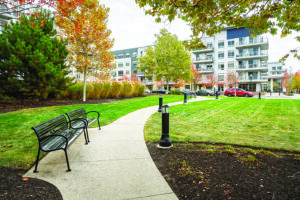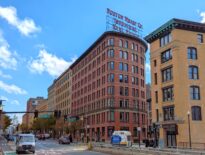
Bowen Park and the Portside apartment development on East Boston’s waterfront. A new analysis found that Greater Boston housing production is poised to fall 44 percent. iStock photo
Is this really the discussion we need to be having right now?
Housing researchers are offering a warning about the Healey administration’s claims that Massachusetts is doing somewhat better in boosting housing production – thanks, of course, to the governor’s policies.
Things got rolling earlier this fall, when the administration released a report stating that around 90,000 new single-family houses, condominiums and apartments were now “in the pipeline” across the state.
What could be better than that for Healey, who is up for reelection next year and faces a growing field of potential Republican challengers?
That would be the more than 63,000 new houses, condos and apartments that the same report contends have been completed and hit the market from the start of Healey’s term in January 2023 through this July.
Report Critiques Healey’s Message
The numbers were a bit of a surprise, coming in somewhat higher than previous estimates. State housing officials mined a new, and more accurate, Census Bureau database that tracks new addresses.
The stats sounded even more impressive given that the governor, back in February, unveiled a plan to “bring down costs” through the construction of 220,000 new housing units over the next decade.
Yet context is important. Healey’s 220,000-unit goal has been criticized as too low by some housing experts. It amounts to somewhat over 20,000 new units a year.
By comparison, back in the 1970s and ’80s, Massachusetts was putting up 30,000 to 40,000 new homes each year, in a state that had a million fewer residents.
Enter, the Boston Foundation’s research team.
TBF’s Boston Indicators think-tank released a brief last week that offered a veiled critique of the Healey housing team’s claims of big progress in boosting housing production
Yes, Massachusetts did add nearly 100,000 units over the last five years, the researchers found after delving into that Census Bureau database of new addresses.
However, a dramatic falloff in housing construction looms in the Boston area and statewide over the coming years, as the impact of higher interest rates and higher construction costs takes its toll, the report warns.
So far in 2025, roughly 4,500 building permits for new single-families, apartments and condos have been issued in Greater Boston, a 44 percent drop from 2021, which saw the highest residential activity of the past decade, Boston Indicators found.

Scott Van Voorhis
The Real Issue: Bringing Prices Down
Yet the real issue is not whether we have been making modestly more or less progress than expected in spurring new residential construction.
Rather, it’s whether Massachusetts is actually adding enough housing at a swift-enough pace to at least slow the pace of price and rent increases. Or, better yet, to actually start to bring them down to address the high cost of doing business that holds the Massachusetts economy back.
Based on the latest numbers from real estate data firm The Warren Group, that is clearly not happening.
Statewide, the price of a home in Massachusetts has risen 3 percent so far this year through the end of September, hitting the $640,000 mark, according to The Warren Group, publisher of Banker & Tradesman.
That’s up from $440,000 during the same period in 2020, and $299,000 in 2010.
Clearly, the pace at which prices are increasing has sped up dramatically, with the statewide median price rising by $200,000 in just five years during the first half of the 2020s.
Meanwhile, Greater Boston home prices topped $803,000 through the end of September, company reported.
“The problem is that even with these recent increases, vacancies remain low, and prices remain elevated across Greater Boston, as we show in later sections of this year’s Housing Report Card,” the Boston Indicators research team wrote in its report. “Clearly, we need far more housing than we currently have.”
Scott Van Voorhis is Banker & Tradesman’s columnist and publisher of the Contrarian Boston newsletter; opinions expressed are his own. He may be reached at sbvanvoorhis@hotmail.com.





